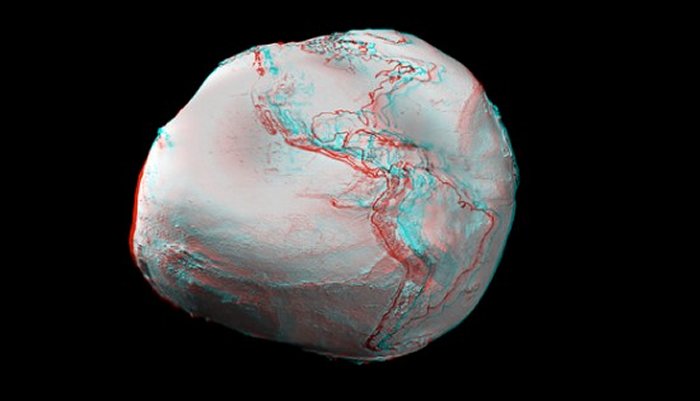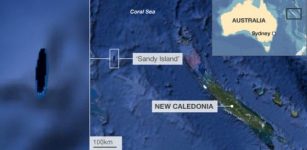Large Parts Of Canada Are Missing Gravity
MessageToEagle.com – Scientists have tried to solve the mystery of why large parts of Canada are missing gravity.
In the in the 1960s when the Earth’s global gravity fields were being mapped and registered, experts noticed a gravity anomaly in the Hudson Bay region and surrounding areas.
Compared to other parts of the world, gravity was much lower in these parts of Canada. How is it possible and what is behind this scientific enigma?
It is by no means uncommon that gravity varies on different parts of the Earth. Studies show that the Earth’s mass is not spread out proportionally and it can shift position over time.
Scientists are able to map Earth’s gravity field from space and to look for small changes from one year to another.
Some years ago, scientists at the Harvard-Smithsonian Center for Astrophysics and the University of Toronto, measure our planet’s gravity with help of a sensitive pair of NASA satellites named GRACE. The results of their study confirmed the current theory that that 20,000 years ago, Ice Age glaciers pressed down on the area’s crust like a person sitting on an extremely viscous waterbed.
The GRACE data allowed scientists to create topographical maps approximating what Hudson Bay looked like during the last ice age, when it was covered by the Laurentide Ice Sheet, which covered much of present-day Canada and the northern United States.
See also:
Door To Hell In Turkmenistan: Giant Darvaza Crater Has Been On Fire For Years
Earth’s Core Is As Hot As The Surface Of The Sun
This ice sheet was almost 2 miles (3.2 km) thick in most sections, and in two areas of Hudson Bay, it was 2.3 miles (3.7 km) thick. It was also very heavy and weighed down the Earth. Over a period of 10,000 years, the Laurentide Ice Sheet melted, finally disappearing 10,000 years ago. It left a deep indentation in the Earth.
Scientists discovered that the weight of all of that ice forced the mantle rocks to ooze slowly sideways. The ice melted rapidly enough the crust hasn’t yet fully bounced back. According to experts, the rebound accounts for about half of the gravity loss.
If a downwelling mantle plume was the culprit, then there wouldn’t be any detectable changes, because mantle convection occurs on fairly long time scales,” Mark Tamisiea, a geophysicist at the Proudman Oceanographic Laboratory in Liverpool, England said
There was a signal, however—the area’s gravity is increasing at a rate comparable to that which would occur if you poured two inches (five centimeters) of water across the region each year.
“It’s a fairly large signal,” Tamisiea said.

It probably means that the region is rebounding around half an inch (about a centimeter) per year.
It should be added that the ice sheet theory only accounts for 25 percent to 45 percent of the gravitational variation around Hudson Bay and the surrounding area. Subtracting the “rebound effect” from the area’s gravitational signal, scientists have determined that the remaining 55 percent to 75 percent of gravitational variation is likely due to convection.
Canada’s Hudson Bay area will experience less gravity for a long time. Scientists estimate that the Earth has to rebound more than 650 feet to get back to its original position, which should take about 5,000 years, but the rebound effect is still visible.
Although sea levels are rising around the world, the sea level along Hudson Bay’s coast is dropping as the land continues to recover from the weight of the Laurentide Ice Sheet.
MessageToEagle.com
Related Posts
-
 Why Is A Biscuit Named After Giuseppe Garibaldi – Italy’s Military Leader And Hero?
No Comments | Feb 19, 2017
Why Is A Biscuit Named After Giuseppe Garibaldi – Italy’s Military Leader And Hero?
No Comments | Feb 19, 2017 -
 Dramatic ‘Shiprock’ Mountain – Sacred To The Navajos As ‘The Rock With Wings’
No Comments | Jun 30, 2016
Dramatic ‘Shiprock’ Mountain – Sacred To The Navajos As ‘The Rock With Wings’
No Comments | Jun 30, 2016 -
 Legendary Furies – Angry And Monstrous Women Of The Underworld
No Comments | Dec 23, 2014
Legendary Furies – Angry And Monstrous Women Of The Underworld
No Comments | Dec 23, 2014 -
 What Would The Fifth Dimension Look Like?
No Comments | Jul 8, 2019
What Would The Fifth Dimension Look Like?
No Comments | Jul 8, 2019 -
 Extraterrestrial Artifacts In Our Solar System Could Exist And Observe Us – Scientists Say
No Comments | Sep 8, 2015
Extraterrestrial Artifacts In Our Solar System Could Exist And Observe Us – Scientists Say
No Comments | Sep 8, 2015 -
 The Lost Prophecy Reveals Chilling Future Events – The Last Words To Mankind?
No Comments | Jan 24, 2015
The Lost Prophecy Reveals Chilling Future Events – The Last Words To Mankind?
No Comments | Jan 24, 2015 -
 Himiko Cloud: Most Massive Object In The Early Universe
No Comments | Feb 4, 2016
Himiko Cloud: Most Massive Object In The Early Universe
No Comments | Feb 4, 2016 -
 Mysterious Disappearance Of Sandy Island
No Comments | Nov 22, 2012
Mysterious Disappearance Of Sandy Island
No Comments | Nov 22, 2012 -
 Mysterious Orbs – Are They Energy Beings From Outside Of Our Reality?
No Comments | Apr 3, 2017
Mysterious Orbs – Are They Energy Beings From Outside Of Our Reality?
No Comments | Apr 3, 2017 -
 Unraveling The Secrets Behind Pope’s Mitre Shaped Like A Fish And The Dogon Connection
No Comments | Apr 9, 2017
Unraveling The Secrets Behind Pope’s Mitre Shaped Like A Fish And The Dogon Connection
No Comments | Apr 9, 2017


